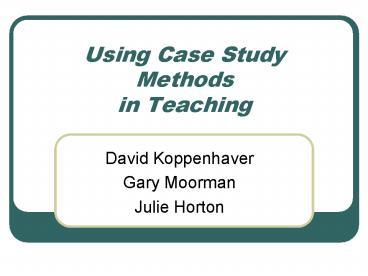Using Case Study Methods in Teaching PowerPoint PPT Presentation
1 / 18
Title: Using Case Study Methods in Teaching
1
Using Case Study Methods in Teaching
- David Koppenhaver
- Gary Moorman
- Julie Horton
2
Classic Case Study
- Harvard Business School Format
- Barnes, Christensen, Hansen (1994)
- Christensen, Garvin, Sweet (1991)
- Shapiro (1975)
3
Case method
- Widely used in training programs of many
professions including - Business
- Law
- Medicine
- Political science
- Public policy
- Teacher education
4
Key Issues in Case Method
- Discussion
- Developing tools of reflective practice
- Test theories and beliefs against real people and
problems - Professional competence
- Does not develop solely through cognitive
learning experiences prior to practice. - Habits and beliefs that most influence practice
develop during initial years of practice.
5
Case Stories
- Blends aspects of case-study with storytelling
- Requires students to develop case stories
- Use personal experiences to create authentic
scenarios - Helps students share personal practices and
dilemmas - Promotes understanding by encouraging reflection
on practice - Contributes to authenticity in classroom
- Contributes to greater student involvement in
classroom - Bridges gap between theory and practice
6
Case Story Model
- The free write
- Writing case story
- Telling and listening to case stories
- Small group reflection on case story process
- Whole group reflection on case story process
- Conclusion
7
Key Differences
- Case Studies
- Captures multiple points of view
- More objective
- Author gathers background information
- More detail, evidence
- Case Stories
- Captures storytellers point of view
- More subjective
- Story is written from within
8
Advantages
- Students appreciate authenticity of experience.
- real people in real life situations
- learn from the field
- increased awareness of complexities and
challenges of the field - complements the text
- Apply real readings and experiences in real life
situation - Contextualize learning
- Bridge theory and practice
9
Advantages
- Active Learning
- Students appreciate engaged learning
- Students think critically about problems of
practice - Students appreciate challenge of confronting
genuine challenge without knowing how ithad been
resolved
10
Advantages
- Cases bridge theory and practice
- Must attempt to reconcile best practice and real
events. - Illuminates diverse perspectives
- Case discussions enable students to see multiple
perspectives in a situation.
11
A Decision-Making Process
- Identify the problem.
- Analyze contributing factors.
- Identify available options.
- Consider the potential outcomes of each option.
- Decide on a course of action to follow.
12
Identify the Problem
- Consider situation that concerns you from
different perspectives of people involved. - Is there really a problem? Whose problem?
- Write a description of the problem and what must
be changed or resolved to improve it. - Be specific.
13
Analyze Contributing Factors
- Consider what contributed to present situation.
- What actions in past or present caused problem or
are maintaining less desirable situation? - Consider also actors cultural backgrounds,
personal values, emotional needs. - Consider alternative explanations (to guard
against bias).
14
Identify Contributing Factors
- Tendency to arrive at solution quickly and take
action. - Especially if confident in our knowledge and
skills relative to problem. - Consider alternative solutions.
- Think broadly and do not dismiss any option.
- Consider Plan A, B, C, etc.
15
Consider Potential Outcomes of Each Solution
- Review alternative solutions
- What are potential advantages and disadvantages?
- Both short- and long-term.
- Costs in finances, emotion, time, energy.
- Is outcomes worth the costs?
16
Decide of Course of Action
- Select most promising alternative.
- Flesh out details.
- Put into action.
- Be mindful that course of action may not have
anticipated effects. - Repat the process as needed.
17
Two Decision-Making Processes
- Identify the problem.
- Analyze contributing factors.
- Identify available options.
- Consider the potential outcomes of each option.
- Decide on a course of action to follow.
- (McWilliams Bailey, 1993)
- Observe
- Interpret
- Hypothesize
- Make a curricular decision
- (Stephens et al., 1996)
18
Readings
- Ackerman et al.
- Stephens et al. (1996). Language Arts, 73,
105-112.

